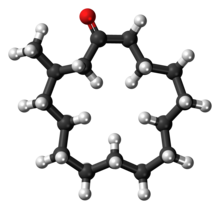Muscone

| |

| |
| Names | |
|---|---|
| Preferred IUPAC name
(3R)-3-Methylcyclopentadecan-1-one | |
| Identifiers | |
3D model (JSmol)
|
|
| ChEMBL | |
| ChemSpider | |
| ECHA InfoCard | 100.007.997 |
| EC Number |
|
PubChemCID
|
|
| UNII | |
CompTox Dashboard(EPA)
|
|
| |
| |
| Properties | |
| C16H30O | |
| Molar mass | 238.415g·mol−1 |
| Density | 0.9221 g/cm3 |
| Melting point | −15 °C (5 °F; 258 K) |
| Boiling point | 328 °C (622 °F; 601 K) |
| Hazards | |
| NFPA 704(fire diamond) | |
Except where otherwise noted, data are given for materials in theirstandard state(at 25 °C [77 °F], 100 kPa).
| |
Musconeis amacrocyclicketone,anorganic compoundthat is the primary contributor to the odor ofmusk.Natural muscone is obtained from musk, a glandular secretion of themusk deer,which has been used in perfumery and medicine for thousands of years. Since obtaining natural musk requires killing the endangered animal, nearly all muscone used in perfumery and for scenting consumer products today is synthetic. It has the characteristic smell of being "musky".
Chemical structure and synthesis
[edit]The chemical structure of muscone was first elucidated byLeopold Ružička.It is a 15-membered ring ketone with onemethylsubstituent in the 3-position. It is an oily liquid that is found naturally as the (−)-enantiomer,(R)-3-methylcyclopentadecanone. Muscone has been synthesized as the pure (−)-enantiomer as well as theracemate.It is very slightly soluble in water and miscible with alcohol.
Oneasymmetric synthesisof (−)-muscone begins with commercially available (+)-citronellal,and forms the 15-membered ring viaring-closing metathesis:[1]

A more recent enantioselective synthesis involves anintramolecularaldol addition/dehydration reactionof amacrocyclicdiketone.[2]
Isotopologs
[edit]Isotopologsof muscone have been used in a study of the mechanism ofolfaction.Global replacement of all hydrogen atoms in muscone was achieved by heating muscone inheavy water(D2O) at 150 °C in the presence of arhodiumon carbon catalyst.[3]It was found that the humanmusk-recognizing receptor,OR5AN1,identified using a heterologousolfactory receptorexpression system and robustly responding to muscone, fails to distinguish between muscone and the so-prepared isotopologin vitro.[3]OR5AN1 is reported to bind to muscone and related musks such ascivetonethrough hydrogen-bond formation from tyrosine-258 along with hydrophobic interactions with surrounding aromatic residues in the receptor.[4]
References
[edit]- ^Kamat, V. P.; Hagiwara, H.; Katsumi, T.; Hoshi, T.; Suzuki, T.; Ando, M. (2000). "Ring Closing Metathesis Directed Synthesis of (R)-(−)-Muscone from (+)-Citronellal".Tetrahedron.56(26): 4397–4403.doi:10.1016/S0040-4020(00)00333-1.
- ^Knopff, O.; Kuhne, J.; Fehr, S. (2007). "Enantioselective Intramolecular Aldol Addition/Dehydration Reaction of a Macrocyclic Diketone: Synthesis of the Musk Odorants (R)-Muscone and (R,Z)-5-Muscenone ".Angew. Chem. Int. Ed.46(8): 1307–1310.doi:10.1002/anie.200604518.PMID17211908.
- ^abBlock, E.; et al. (2015)."Implausibility of the Vibrational Theory of Olfaction".Proc. Natl. Acad. Sci. USA.112(21): E2766–E2774.Bibcode:2015PNAS..112E2766B.doi:10.1073/pnas.1503054112.PMC4450420.PMID25901328.
- ^Ahmed, L.; et al. (2018)."Molecular Mechanism of Activation of Human Musk Receptors OR5AN1 and OR1A1 by (R)-Muscone and Diverse Other Musk-smelling Compounds".Proc. Natl. Acad. Sci. USA.115(17): E3950–E3958.Bibcode:2018PNAS..115E3950A.doi:10.1073/pnas.1713026115.PMC5924878.PMID29632183.

